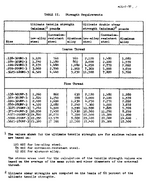dcascap
Aerospace
- Feb 6, 2024
- 46
Hi,
For NAS517 screws, which it suppose that they have a min tensile strength of 160 ksi according to the spec.
Can I use this value as max strength of the screw in tension? Or should I somehow calculate also if the countersunk head fails before the shank?
The later is quite difficult in the case of a countersunk, even though I could make some kind of approximation.
I attach to the post the link of the specs.
For NAS517 screws, which it suppose that they have a min tensile strength of 160 ksi according to the spec.
Can I use this value as max strength of the screw in tension? Or should I somehow calculate also if the countersunk head fails before the shank?
The later is quite difficult in the case of a countersunk, even though I could make some kind of approximation.
I attach to the post the link of the specs.

